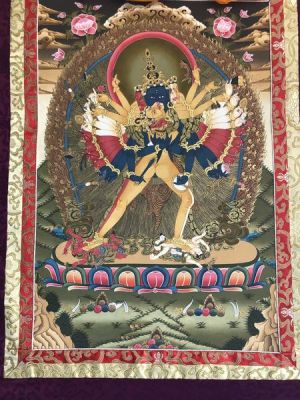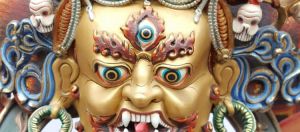Meditational Deities (ishtadevata, yi dam)
Meditational Deity (yi dam, ishtadevata): a chosen, or personal meditational deity. It is a broad tantric technical classification for deities. An Ishtadevata can be almost any deity that is classified in Tantric literature of Vajrayana Buddhism as a 'wisdom deity' meaning it is an enlightened deity or an emanation of an enlightened deity, i.e. a Buddha. In Himalayan art the images of deities are primarily Buddhist but not exclusively.
Meditational deities can also be divided into two groups of higher and lower. The deities of the kriya, charya and yoga belong to the three lower tantras. The highest meditational deities belong to the fourth level of tantra - Yoganiruttara. The distinction between the two groups is based on tantric theory where the lower group only has generation stage yoga as a method of practice. The Yoganiruttara has both generation stage yoga and perfection stage yoga as the special meditation technique.
Tibetan Buddhism examples of meditational deities might be for the Nyingma - Vajrakila; Sakya - Hevajra; Kagyu - Chakrasamvara; Gelugpa - Vajrabhairava and the Jonang - Kalachakra. In practice, these deities are generally selected from the inventory of principal meditation practices common to a particular spiritual lineage or tradition.
Figures that are not meditational deities from a Vajrayana Buddhist perspective are all worldly deities, protectors that are not considered enlightened, Hindu gods, Bon gods and deities.
In the Sarma Tradition the deities chosen belong to the Four Classes of Buddhist Tantra:
(1) Kriya Tantra
(2) Charya Tantra
(3) Yoga Tantra
For the Bon religion examples of meditational deities are: Walse Ngampa and Magyu. For the various Hindu traditions deity selections might be Shaiva - Bhairava; Shakta - Durga or Kali; Vaishnava - Rama or Krishna.
Meditational deities can also be divided into two groups of higher and lower. The deities of the kriya, charya and yoga belong to the three lower tantras. The highest meditational deities belong to the fourth level of tantra - Yoganiruttara. The distinction between the two groups is based on tantric theory where the lower group only has generation stage yoga as a method of practice. The Yoganiruttara has both generation stage yoga and perfection stage yoga as the special meditation technique.
(Jeff Watt )
Source
[[1]]

